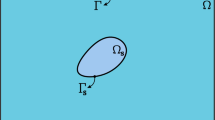Abstract
The flow of an incompressible Newtonian fluid with a free boundary in contact with air is considered. In this paper, there will be problems with a flat bottom for different initial and boundary conditions. The choice of these tasks is based on the principle of “from simple to complex”. This stage is considered as the initial and “debugging” in the development of the CABARET technique in application to the problems of incompressible fluid flows with a free surface. The system of equations describing such a model of the medium is a transformed Navier-Stokes system in a curvilinear coordinate system, such that at any instant the curvilinear transformation conforms the computational domain into a rectangle of unit height. The free surface is described by the kinematic boundary condition, which is obtained from the assumption that the liquid particles located on the interface between the two media remain on this boundary all the time. The comparison of numerical results with some theoretical data is discussed.
Access this chapter
Tax calculation will be finalised at checkout
Purchases are for personal use only
Similar content being viewed by others
References
Gushchin, V.A., Konshin, V.N.: Computational aspects of the splitting method for incompressible flow with free surface. J. Comput. Fluids 21(3), 345–353 (1992). https://doi.org/10.1016/0045-7930(92)90043-U
Belotserkovskii, O.M., Gushchin, V.A., Kon’shin, V.N.: The splitting method for investigating flows of a stratified liquid with a free surface. USSR Comput. Math. Math. Phys. 27(2), 181–191 (1987). https://doi.org/10.1016/0041-5553(87)90175-3
Gushchin, V.A., Kondakov, V.G.: On cabaret scheme for incompressible fluid flow problems with free surface. In: International Multidisciplinary Scientific GeoConference Surveying Geology and Mining Ecology Management, SGEM 2017, no. 21, pp. 485–492 (2017)
Barker, S.J., Crow, S.C.: The motion of two-dimensional vortex pairs in a ground effect. J. Fluid Mech. 82(4), 659–671 (1977). https://doi.org/10.1017/S0022112077000913
Peace, A.J., Riley, N.: A viscous vortex pair in ground effect. J. Fluid Mech. 129, 409–426 (1983). https://doi.org/10.1017/S002211208300083X
Karabasov, S.A., Goloviznin, V.M.: Compact accurately boundary-adjusting high-resolution technique for fluid dynamics. J. Comput. Phys. 228(19), 7426–7451 (2009). https://doi.org/10.1016/j.jcp.2009.06.037
Faranosov, G.A., Goloviznin, V.M., Karabasov, S.A., Kondakov, V.G., Kopiev, V.F., Zaitsev, M.A.: CABARET method on unstructured hexahedral grids for jet noise computation. Comput. Fluids 88, 165–179 (2013). https://doi.org/10.1016/j.compfluid.2013.08.011
Goloviznin, V.M., Karabasov, S.A., Kondakov, V.G.: Generalization of the CABARET scheme to two-dimensional orthogonal computational grids. Math. Models Comput. Simul. 6(1), 56–79 (2014). https://doi.org/10.1134/S2070048214010050
Goloviznin, V.M., Zaitsev, M.A., Karabasov, S.A., Korotkin, I.A.: New CFD Algorithms for Multiprocessor Computer Systems. Mosk. Gos. Univ, Moscow (2013). [in Russian]
Goloviznin, V.M., Samarskii, A.A.: Finite difference approximation of convective transport equation with space splitting time derivative. Matematicheskoe Modelirovanie 10(1), 86–100 (1998). [in Russian]
Goloviznin, V.M., Karabasov, S.A.: Nonlinear correction of Cabaret scheme. Matematicheskoe Modelirovanie 10(12), 107–123 (1998). [in Russian]
Author information
Authors and Affiliations
Corresponding author
Editor information
Editors and Affiliations
Rights and permissions
Copyright information
© 2019 Springer Nature Switzerland AG
About this paper
Cite this paper
Gushchin, V.A., Kondakov, V.G. (2019). On One Method for Solving of a Non-stationary Fluid Flows with Free Surface. In: Dimov, I., Faragó, I., Vulkov, L. (eds) Finite Difference Methods. Theory and Applications. FDM 2018. Lecture Notes in Computer Science(), vol 11386. Springer, Cham. https://doi.org/10.1007/978-3-030-11539-5_30
Download citation
DOI: https://doi.org/10.1007/978-3-030-11539-5_30
Published:
Publisher Name: Springer, Cham
Print ISBN: 978-3-030-11538-8
Online ISBN: 978-3-030-11539-5
eBook Packages: Computer ScienceComputer Science (R0)




